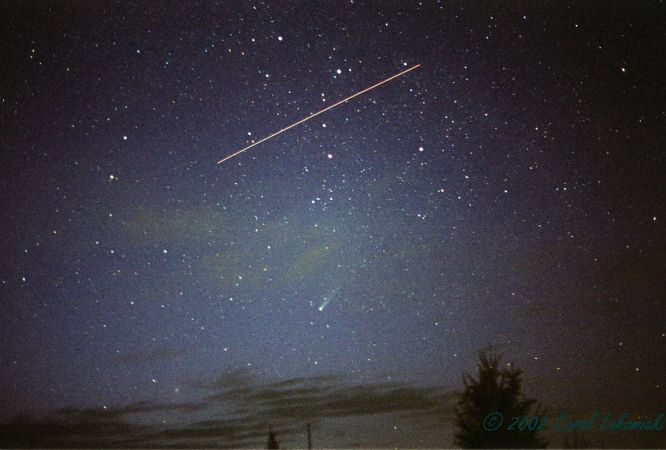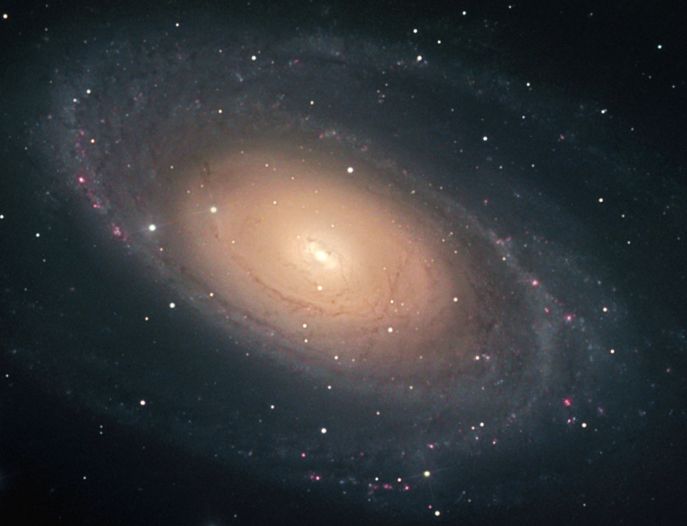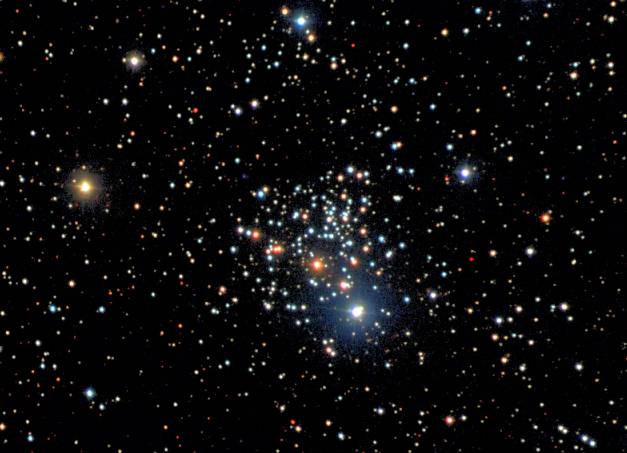Earth, Comets, Galaxies & Stars
Most pics courtesy of NASA
Comet and Aurora Over Alaska


Explanation: Can you spot the comet? Flowing across the frozen Alaskan landscape is an easily visible, colorful aurora. Just to the lower left, however, well in the background, is something harder to spot: Comet Ikeya-Zhang, the brightest comet of recent years. Although the aurora faded in minutes, the comet is just now beginning to fade. It remains just barely visible without aid, however, before sunrise in the East. The comet is actually a giant dirt-covered snowball that spends most of its time in the outer Solar System -- to where it now returns. The above photograph was taken on March 20, 2002, when Comet Ikeya-Zhang was near its brightest. Careful inspection of the photo will uncover several other sky delights, including the giant galaxy M31.

Explanation: This gorgeous galaxy and comet portrait was recorded on April 5th, 2002, in the skies over the Oriental Pyrenees near Figueres, Spain. From a site above 1,100 meters, astrophotographer Juan Carlos Casado used a guided time exposure, fast film, and a telephoto lens to capture the predicted conjunction of the bright Comet Ikeya-Zhang (right) and the Andromeda Galaxy (left). This stunning celestial scene would also have been a rewarding one for the influential 18th century comet hunter Charles Messier. While Messier scanned French skies for comets, he carefully cataloged positions of things which were fuzzy and comet-like in appearance but did not move against the background stars and so were definitely not comets. The Andromeda Galaxy, also known as M31, is the 31st object in his famous not-a-comet catalog. Not-a-comet object number 110, a late addition to Messier's catalog, is one of Andromeda's small satellite galaxies, and can be seen here just below M31. Our modern understanding holds that the Andromeda galaxy is a large spiral galaxy some 2 million light-years distant. The photogenic Comet Ikeya-Zhang, now a lovely sight in early morning skies, is about 80 million kilometers from planet Earth.

Explanation: Still catching the Sun's rays, the International Space Station (ISS) cruises across the early evening sky above Tomahawk, Wisconsin, USA. Recorded on April 9, 2002 around 9 pm CDT in a 30 second exposure, the sunlit space station traced this bright streak moving east (right) through the constellation Cassiopeia. Below lies Comet Ikeya-Zhang sporting a visible tail. But while this photogenic comet is now fading from view, the ISS will be getting brighter. Hours after this picture was taken, the Space Shuttle Atlantis docked with the ISS, bringing another structure to add to the growing orbital outpost.

Explanation: In this stunning vista recorded with the Hubble Space Telescope's new advanced camera, distant galaxies form a dramatic backdrop for disrupted spiral galaxy Arp 188, the Tadpole Galaxy. The cosmic Tadpole is a mere 420 million light-years distant toward the northern constellation Draco. Its eye-catching tail is about 280 thousand light-years long and features massive, bright blue star clusters. One story goes that a more compact intruder galaxy crossed in front of Arp 188 - from left to right in this view - and was slung around behind the Tadpole by their gravitational attraction. During the close encounter, tidal forces drew out the spiral galaxy's stars, gas, and dust forming the spectacular tail. The intruder galaxy itself, estimated to lie about 300 thousand light-years behind the Tadpole, can be seen through foreground spiral arms at the upper left. Following its terrestrial namesake, the Tadpole Galaxy will likely loose its tail as it grows older, the tail's star clusters forming smaller satellites of the large spiral galaxy.

Explanation: Big and beautiful spiral galaxy M81, in the northern constellation Ursa Major, is one of the brightest galaxies visible in the skies of planet Earth. This superbly detailed view reveals its bright nucleus, grand spiral arms and sweeping cosmic dust lanes with a scale comparable to the Milky Way. Hinting at a disorderly past, a remarkable dust lane runs straight through the disk, below and right of the galactic center, contrary to M81's other prominent spiral features. The errant dust lane may be the lingering result of a close encounter between M81 and its smaller companion galaxy, M82. Scrutiny of variable stars in M81 (aka NGC 3031) has yielded one of the best determined distances for an external galaxy -- 11.8 million light-years.

Explanation: Supernova remnant N132D shows off complex structures in this sharp, color x-ray image. Still, overall this cosmic debris from a massive star's explosive death has a strikingly simple horseshoe shape. While N132D lies 180,000 light-years distant in the Large Magellanic Cloud, the expanding remnant appears here about 80 light-years across. Light from the supernova blast which created it would have reached planet Earth about 3,000 years ago. Observed by the orbiting Chandra Observatory, N132D still glows in x-rays, its shocked gas heated to millions of degrees Celsius. Since x-rays are invisible, the Chandra x-ray image data are represented in this picture by assigning visible colors to x-rays with different energies. Low energy x-rays are shown as red, medium energy as green, and high energy as blue colors. These color choices make a pleasing picture and they also show the x-rays in the same energy order as visible light photons, which range from low to high energies as red, green, and blue.

Explanation: The New General Catalog of star clusters and nebulae really isn't so new. In fact, it was published in 1888 - an attempt by J. L. E. Dreyer to consolidate the work of astronomers William, Caroline, and John Herschel along with others into a useful, single, complete catalog of astronomical discoveries and measurements. Dreyer's work was successful and is still important today as this famous catalog continues to lend its "NGC" to bright clusters, galaxies, and nebulae. Take for example this star cluster known as NGC 2266 (item number 2,266 in the NGC compilation). It lies about 10,000 light-years distant in the constellation Gemini and represents an open or galactic cluster. With an age of about 1 billion years, NGC 2266 is old for a galactic cluster. Its evolved red giant stars are readily apparent in this gorgeous three-color image.

Explanation: Gazing across this gorgeous skyscape, the Southern Cross and stars of the constellation Centaurus are seen above the outline of Mauna Loa (Long Mountain), planet Earth's largest volcano. Unfamiliar to sky gazers north of about 25 degrees North Latitude, the Southern Cross, constellation Crux, is near the horizon to the left of Mauna Loa's summit. A compact constellation of bright stars, the long axis of the cross conveniently points south toward the southern celestial pole. The top of the cross is marked by the lovely pale red star Gamma Crucis, which is in fact a red giant star about 120 light-years distant. Stars of the grand constellation Centaurus almost engulf the Southern Cross with blue giant Beta Centauri, and yellowish Alpha Centauri, appearing as the brightest stars to the left of Gamma Crucis. At a distance of 4.3 light-years, Alpha Centauri, the closest star to the Sun, is actually a triple star system which includes a star similar to the Sun. But what caused the reddish streaks in the foreground of this time exposure? Alas, it is the mundane glow of lights from cars (not molten lava!) traveling the road to Hilo, Hawaii.
|